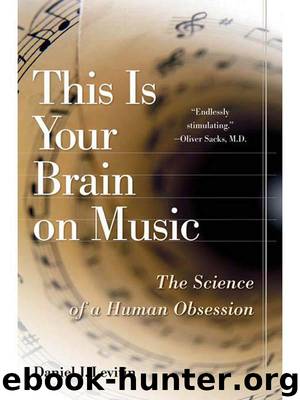This Is Your Brain on Music by Daniel J. Levitin

Author:Daniel J. Levitin
Language: eng
Format: mobi, epub
Publisher: Penguin Group USA, Inc.
Published: 2011-12-14T04:44:57+00:00
6. After Dessert, Crick Was Still Four Seats Away from Me
Music, Emotion, and the Reptilian Brain
As I’ve discussed, most music is foot-tapping music. We listen to music that has a pulse, something you can tap your foot to, or at least tap the foot in your mind to. This pulse, with few exceptions, is regular and evenly spaced in time. This regular pulse causes us to expect events to occur at certain points in time. Like the clickety-clack of a railroad track, it lets us know that we’re continuing to move forward, that we’re in motion, that everything is all right.
Composers sometimes suspend the sense of pulse, such as in the first few measures of Beethoven’s Fifth Symphony. We hear “bump-bump-bump-baaaah” and the music stops. We’re not sure when we’re going to hear a sound again. The composer repeats the phrase—using different pitches—but after that second rest, we’re off and running, with a regular foot-tappable meter. Other times, composers give us the pulse explicitly, but then intentionally soften its presentation before coming in with a heavy articulation of it for dramatic effect. “Honky Tonk Women” by the Rolling Stones begins with cowbell, followed by drums, followed by electric guitar; the meter stays the same and our sense of the beat does, too, but the intensity of the strong beats unfolds. (And when we listen on headphones the cowbell comes out of only one ear for more dramatic effect.) This is typical of heavy metal and rock anthems. “Back in Black” by AC/DC begins with the high-hat cymbal and muted guitar chords that sound almost like a small snare drum for eight beats until the onslaught of electric guitar comes in. Jimi Hendrix does the same thing in opening “Purple Haze”—eight quarter notes on the guitar and bass, single notes that explicitly set up the meter for us before Mitch Mitchell’s thunderous drums are ushered in. Sometimes composers tease us, setting up expectations for the meter and then taking them away before settling on something strong—a sort of musical joke that they let us in on. Stevie Wonder’s “Golden Lady” and Fleetwood Mac’s “Hypnotized” establish a meter that is changed when the rest of the instruments come in. Frank Zappa was a master at this.
Some types of music seem more rhythmically driven than others, of course. Although “Eine Kleine Nachtmusik” and “Stayin’ Alive” both have a definable meter, the second one is more likely to make most people get up and dance (at least that’s the way we felt in the 1970s). In order to be moved by music (physically and emotionally) it helps a great deal to have a readily predictable beat. Composers accomplish this by subdividing the beat in different ways, and accenting some notes differently than others; a lot of this has to do with performance as well. When we talk about a great groove in music, we’re not talking in some jive sixties Austin Powers fab lingo, baby; we’re talking about the way in which these beat divisions create a strong momentum.
Download
This Is Your Brain on Music by Daniel J. Levitin.epub
This site does not store any files on its server. We only index and link to content provided by other sites. Please contact the content providers to delete copyright contents if any and email us, we'll remove relevant links or contents immediately.
| Appreciation | Blank Sheet Music |
| Composition | Conducting |
| Exercises | Instruction & Study |
| Lyrics | MIDI, Mixers, etc |
| Philosophy & Social Aspects | Songwriting |
| Techniques | Theory |
| Vocal |
The Goal (Off-Campus #4) by Elle Kennedy(12489)
Kathy Andrews Collection by Kathy Andrews(10593)
Diary of a Player by Brad Paisley(6878)
What Does This Button Do? by Bruce Dickinson(5554)
Assassin’s Fate by Robin Hobb(5275)
Big Little Lies by Liane Moriarty(4909)
Pale Blue Dot by Carl Sagan(4040)
Sticky Fingers by Joe Hagan(3466)
The Heroin Diaries by Nikki Sixx(2949)
The Death of the Heart by Elizabeth Bowen(2923)
Beneath These Shadows by Meghan March(2739)
The Help by Kathryn Stockett(2717)
Confessions of a Video Vixen by Karrine Steffans(2693)
How Music Works by David Byrne(2559)
Jam by Jam (epub)(2506)
Harry Potter 4 - Harry Potter and The Goblet of Fire by J.K.Rowling(2431)
Strange Fascination: David Bowie: The Definitive Story by David Buckley(2378)
Petty: The Biography by Warren Zanes(2247)
Darker Than the Deepest Sea by Trevor Dann(2224)
